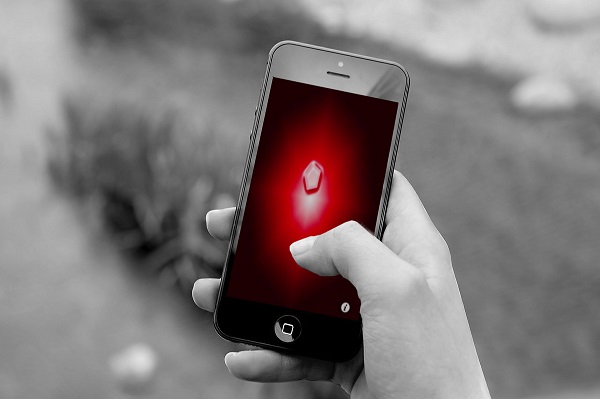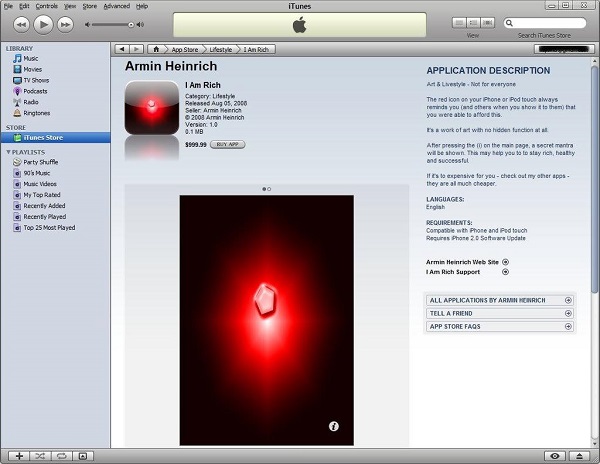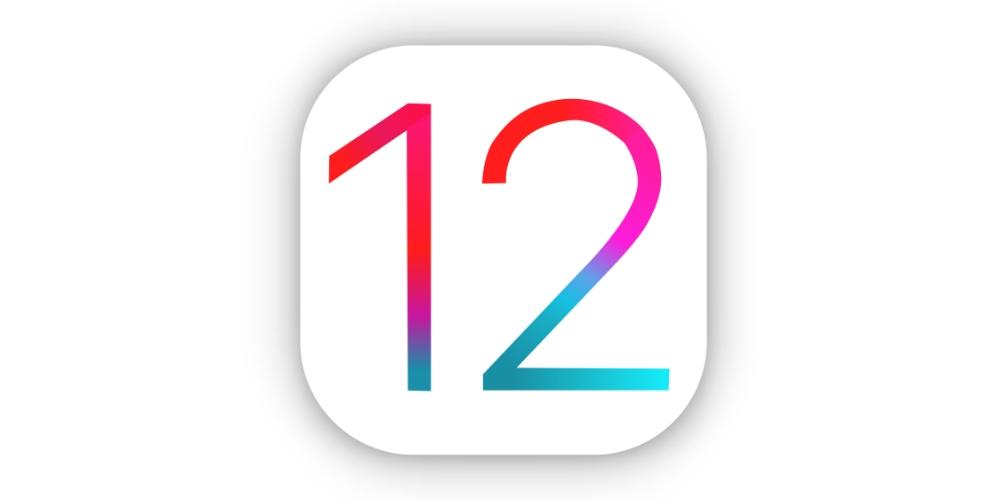«Я богат», или Секретная мантра за $1 000
В начале 2008 года Армин Хайнриш (Armin Heinrich) задумал разработать прибыльное приложение для iPhone и заодно продемонстрировать свое чувство юмора. Он остановился на идее продукта, который абсолютно ничего не делая мог принести ему — ни больше ни меньше — $999,99 с одного покупателя (самая высокая цена за приложение, которую позволяет устанавливать Apple).
Приложение ценой почти в $1 000 I Am Rich («Я богат») должно было служить постоянным напоминанием человеку о том, что он богат. Олицетворением богатства служило изображение красного рубина на экране телефона. Целью Хайнриша являлось создание так называемого «эффекта Веблена», когда товар приобретается исключительно для произведения впечатления на других, а решающее значение в этом играют высокая цена и эксклюзивность продукта. 5 августа 2008 года приложение I Am Rich стало доступным в App Store, а описание гласило следующее:
«Красная иконка на вашем iPhone или iPod touch будет служить постоянным напоминанием вам (и вашим знакомым, когда они увидят ее), что вы были в состоянии позволить себе это.
Это произведение искусства без наличия каких-либо скрытых функций.
После нажатия (i) на главной странице приложения появляется «секретная мантра». Она сможет помочь вам всегда оставаться богатым, здоровым и успешным».
В течение первых нескольких часов приложение успели приобрести 7 человек — 5 из США, 1 из Германии и 1 из Франции. Однако первоначальный замысел Хайнриша провалился: люди приобретали приложение не с целью подчеркнуть таким образом свой социальный статус, а скорее из любопытства, думая, что это некая шутка. Один из покупателей, обнаружив, что с него действительно списали обозначенную сумму, был довольно сильно разозлен и оставил следующий комментарий:
«Это не шутка! Надеюсь, что Apple поможет мне вернуть мои деньги. Вместе с друзьями мы наткнулись на это приложение и шутки ради я нажал «Купить», будучи уверенным в том, что это всего лишь шутка, и желая посмотреть, что же произойдет дальше… Я позвонил в банк и они подтвердили, что с моего счета действительно было списано $999,99. Так что это не шутка. Ни в коем случае не покупайте это приложение. Будьте осторожны. ».
Спустя сутки приложение было удалено Apple из App Store без каких-либо на то объяснений, успев принести Хайнришу $5 600 (с учетом 30% гонорара Apple в размере $2 400).
«Я не имею понятия, почему они убрали его, — сказал Хайнриш в своем интервью Los Angeles Times несколькими днями позже. — Я не нарушил ни единого правила App Store».
Компания Apple, имеющая огромный перечень принципов разработки приложений для IOS, скорее всего, решила, что приложение I Am Rich не является «функциональным» или же классифицировала его как «нежелательный контент».
После фиаско I Am Rich двое из семи покупателей обратились с жалобой к Apple и им был обеспечен полный возврат денежных средств. «Я не хочу собирать деньги с людей, заплативших по ошибке, — сказал позднее Хайнриш. — Я рад, что Apple вернул деньги за эти два заказа».
Хайнриш также признался, что был немного разочарован короткой «жизнью» своего творения, считая, что на него все же имеется спрос. «Уверен, что гораздо больше людей хотели бы приобрести его, но сейчас просто не могут сделать этого. Это приложение было произведением искусства, включавшим в себя «секретную мантру, вот и все». По его словам, некоторые из тех, кто успел приобрести I Am Rich, написали ему благодарственные письма и то, что для них абсолютно не было проблемой потратить эту сумму (хотя это так и не было подтверждено).
О какой же «секретной мантре» стоимостью $1 000 шла речь? Как говорится, все гениальное просто:
«Я богат
Я заслужил это
Я хороший, здоровый и
успешный»
Добавим, что в оригинальном варианте отсутствовали какие-либо знаки препинания, а в слове deserve («заслужить, быть достойным») была допущена модная орфографическая ошибка (deserv).
Уже в следующем году Хайнриш выпустил приложение I Am Rich LE — обновленную версию приложения I Am Rich по более демократичной цене $9,99. Новое приложение обладает уже несколькими функциями, включая в себя: калькулятор для произведения финансовых расчетов, встроенную справочную систему и знаменитую «мантру» (на этот раз без орфографических ошибок).
Данное приложение и по сей день доступно для приобретения в App Store. А среди комментариев к нему встречаются, к примеру, такие:
«Не могли бы вы вернуть первоначальную версию приложения, чтобы оно абсолютно ничего не делало?» — умоляет один из пользователей.
«Это искусство, и оно великолепно, — пишет другой, более удовлетворенный покупатель. — Не все, за что вы платите, должно иметь ценность. К черту практичность».
Источник
What you should know if you have an iPhone 6 (it will be obsolete soon)
Last week we learned that Apple will declare the iPhone 6 and 6 Plus vintage at the end of the month, thus adding to the list of obsolete Apple products. Interestingly, the iPhone 5s that predates these is not yet on the list. Why, then, is it that these are going to be included? What will happen if you have one?
The iPhone 6 meet the requirement of a “vintage” product
Although the term vintage sounds more like products from many decades ago, in technological terms they tend to be much more recent. From Apple they have a premise by which, any device, is added to that list. This occurs when a device stopped being sold more than 5 years ago and less than 7 years ago , also having to meet the requirement of not having been manufactured during that time . Therefore, the iPhone 5s does not comply with this, but the iPhone 6 and 6 Plus if they were officially sold and manufactured in 2015 with the release of the ‘6s’.
What does this mean if you have an iPhone 6?
First of all, don’t worry. Your iPhone 6 or 6 Plus is not going to stop working overnight. You will not see any messages on the screen alerting you to anything. In fact, you can continue using it normally . They are two phones that have had several years of updates until they remain in iOS 12 as the latest version of iOS available, so despite not having the latest features, it still has an advanced system.
In fact, it is possible that you continue to receive security updates in specific cases where it is required, as has happened recently, even for iPhone 4s. It is true that at some point these phones will stop having access to certain applications because developers already require more advanced hardware, but that moment with the main apps still seems a long way off.
Therefore, if you are still a carrier of one of these, you can breathe a sigh of relief. The only thing you will not have access to is official repairs at Apple , since they will no longer have parts and therefore they will only offer you recycling options. Although there are many other third-party technical services that will continue to offer it. So if you take good care of your smartphone and are not yet interested in getting a newer one, you can still continue to use it normally for several more years.
Источник
When to charge your iPhone or iPad
There’s a lot of myth and folklore surrounding charging iOS devices (or actually any device that uses Lithium technology batteries). A lot of it comes from the advice given for older technologies, such as Nickel-Cadmium or Nickel-Metal-Hydride batteries. None of this applies to Lithium, however, and some of what we «know» from the NiCd and NiMH days is actually harmful to modern battery technology.
So what are the «rules» for charging? The most basic one is charge whenever you want to, for a long as you want to. There’s no reason to let the device drain completely before charging (in fact, it’s a bad idea to do that on a regular basis), and there’s no need to wait until it reaches 100% before removing it from the power source. You can charge when it’s at 40% and disconnect when it reaches 80%, or any other values, without hurting the phone. And you don’t have to turn it off to charge it; in fact, you shouldn’t. And you can leave it plugged in while using it if you want to.
The Best Practice, however, is to charge the phone overnight, every night. As it stops automatically at 100% you can’t overcharge it doing this. You thus start the day with a fully charged phone. And, if you configure the phone for automatic backup using iTunes or iCloud, the phone will back up every night when it has a WiFi connection and is asleep.
With iOS 13 and later iOS devices now have an Optimized Charging option. With this enabled, if you charge overnight the phone will stop charging at 80%, then resume charging in time to reach 100% in time to meet your normal usage pattern. During the nighttime pause the phone will use mains power instead of battery power, allowing the battery to “rest”, and thus reducing the need to charge the battery quite as often; over the long term this will extend the useful life of the battery.*SEE NOTE BELOW The phone will resume charging to reach 100% when you are ready to use your phone; it will “learn” your usage pattern. The figure below shows how Optimized Charging works; notice that it started charging when put on a wireless charger around 9:30 PM, stopped charging at 80% a short while later, then resumed charging at 6 AM to reach 100% around 7 AM.
You can charge an iPhone, iPad or iPod Touch with any quality USB-A or USB-C power source and matching cable. Essentially any Apple power source and cable that fit into the connectors at either end are compatible and safe to use. There will be performance differences, with USB-C faster than USB-A to charge, but they will all work (except that a USB-A “cube” doesn’t have sufficient power to charge an iPad). For an iPhone 12 or later you can fast charge using a 20 watt or higher power USB-C that meets the PD spec. The Apple 20 watt and higher is PD compatible, but not all 3rd party power sources are yet.
Want more details?
- The «charger» for an iOS device is built into the device. It is not the thingy that plugs into the wall, and it is not the cable that connects the thingy that plugs into the wall to the phone. They are just a source of current and a way to get it to the phone, respectively.
- Completely draining a Lithium battery, even once, will kill it. (Unlike NiCd and NiMH, which people really would drain completely to prevent «memory effect»).
- The internal charger is «smart» — It will prevent the device from being overcharged, and it will attempt to prevent the device from totally draining the battery by shutting down the device before the battery is fully depleted.
- When the phone shuts off at 0% it really isn’t zero; there’s still sufficient charge on the device to prevent the battery from going completely flat. Likewise, 100% is not the maximum the battery can store; it stops charging slightly short of maximum to prevent overcharging.
- The worst thing you can do is drain the battery to 0%, then not charge it immediately. After it reaches zero and shuts off there’s a small amount of energy left, but if you leave it uncharged for long it WILL go flat and kill the battery. So if it reaches zero, charge it soon (within hours).
- It’s best to charge it when it goes below 20%, primarily to avoid the risk of it going to zero when you don’t have a charger available, and to prevent unexpected shutdowns when you might need the phone. The phone helpfully changes the color of the battery icon to yellow below 20% and enables Low Power mode to preserve the remaining charge for as long as possible.
- Never leave a phone unused for weeks or months on end without periodically recharging it. If it is going to be unused for a long period, Apple recommends leaving it at around 50% charged (not full, and not empty).
- You should only use high quality USB power sources to charge your iOS device. They don’t have to be Apple’s (although Apple makes good ones), but they should never be cheapo USB sources, both because they may damage the phone and they may even injure you.
- You should also use only high quality cables, as cables that do not meet Apple’s «Made for iPhone» (MFI) standards can damage your phone (see: Why Counterfeit Lightning Cables Kill iPhones — Motherboard)
- The power source needs to supply at least 1 amp to charge an iPhone, and 2 amps to charge an iPad. Note, however that a power source that can supply more than these values is OK to use; the internal battery charger will take only what it needs. So, for example, you can safely charge your iPhone with an iPad USB adapter. See this for more details: Using iPad power adapters with your iPhone, iPad, and iPod — Apple Support
- With the iPhone 8 and later you can also charge with a USB-C power source. This will charge the device much faster, but still safely. See this Apple support link—>Fast charge your iPhone — Apple Support
- For fast charging the iPhone 11 the recommended power source is the 13 watt adapter, and for the iPhone 12 and 13 Apple recommends the 20 watt adapter for the fastest charging. However, you can use a higher power adapter safely; the phone will only take the power it needs. Thus, if you have a 61 watt MacBook adapter it is safe to use that.
- iOS devices fast charge until they reach about 75%; the rate then slows down to prevent overcharging. So it will reach 75% very quickly (under an hour), but it can take a couple of hours more to reach full charge.
Finally, keep in mind that batteries are «consumables». Their capacity starts dropping the day they come off the assembly line. Battery life is determined primarily by «full charge cycles» — A full charge cycle is 0% to 100%, or any combination that adds up to 100%, such as 50% to 100% or 30% to 80% twice, 80% to 100% 5 times, etc. The battery will gradually lose capacity, and is rated to remain above 80% capacity (that’s total capacity, not charge level) for 500 full charge cycles for an iPhone (1,000 for an iPad). For most people this will be around 2 years for the iPhone. Apple will replace the battery for a reasonable fee (currently $49 US for older phones, $69 for iPhone X and later) if it goes below 80% after the original 1 year warranty or AppleCare+ warranty period. Within the warranty the replacement is free.
While this tip is specifically for iOS devices, the same principles apply to all other Apple devices (watches, AirPods, MacBooks) as well as most other manufacturer’s products that have Lithium chemistry batteries.
*More about Optimized Charging: I was asked by a user in the iPhone forum (https://discussions.apple.com/thread/251707376?answerId=253281558022#253281558022) why the iPhone does this. There is some evidence that Lithium chemistry batteries should not be left fully charged. So, for example, Tesla recommends not charging the car’s battery beyond 80% unless planning for a long trip, and in fact it can be programmed to do this. That doesn’t mean they should never be fully charged, just that they should not be left at 100% for long periods of time. Most electric bike instructions have the same advice. And Apple recommends storing devices that won’t be used for a while at 50% charge.
When the phone is connected to power and not charging the energy to run the phone comes from the external power source, rather than the battery, thus letting the battery “rest”. And any smartphone is always doing something that uses energy, even when it isn’t actually being used. As the battery’s useful life is measured in full charge cycles, with only a small contribution from chronological age, leaving the battery at 80% but still connected to power achieves 2 aims: Not leaving it at 100% for long periods of time, and reducing the number of full charge cycles while still powering the phone.
Источник







